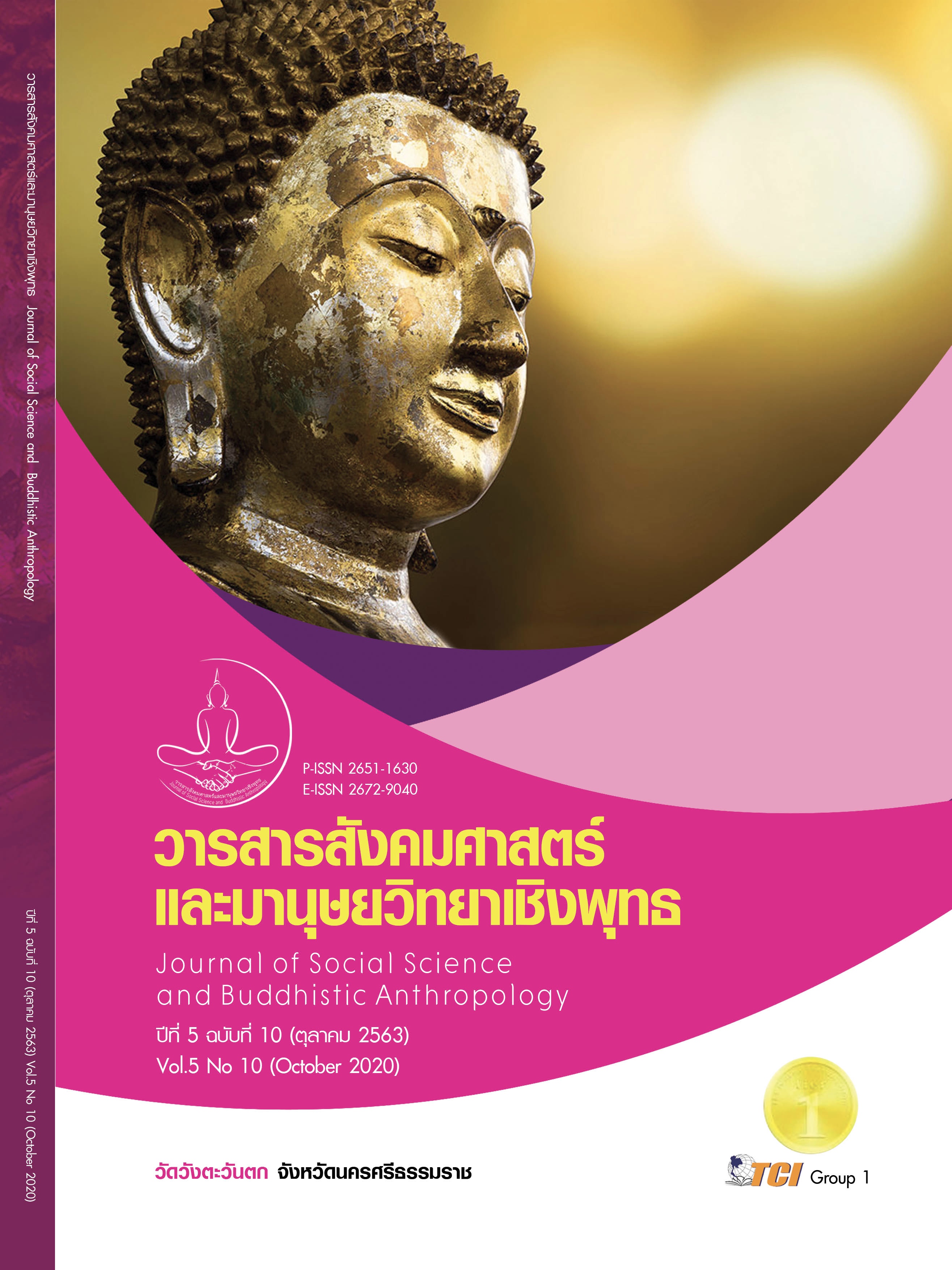การอนุรักษ์อัตลักษณ์ด้านประวัติศาสตร์ถิ่นฐาน ของกลุ่มชาติพันธุ์ลาวเวียงในตำบลพลับพลาไชย อำเภออู่ทอง จังหวัดสุพรรณบุรี
คำสำคัญ:
อัตลักษณ์, ประวัติศาสตร์ถิ่นฐาน, การอนุรักษ์, กลุ่มชาติพันธุ์ลาวเวียงบทคัดย่อ
บทความฉบับนี้มีวัตถุประสงค์ 1) เพื่อศึกษาอัตลักษณ์ด้านประวัติศาสตร์ถิ่นฐานของชาติพันธุ์ของชาวลาวเวียงในตำบลพลับพลาไชย และ 2) เพื่อสร้างวิธีการอนุรักษ์อัตลักษณ์ ด้านประวัติศาสตร์ถิ่นฐานของชาติพันธุ์ลาวเวียงในตำบลพลับพลาไชย เป็นการวิจัยเชิงคุณภาพ โดยใช้การสัมภาษณ์เชิงลึก จากตัวแทนชาวลาวเวียงในพื้นที่ จำนวน 5 คน ผู้นำชุมชนจำนวน 10 คน และการประชุมกลุ่มย่อย จากตัวแทนชาวบ้านในพื้นที่ จำนวน 20 คน เจ้าหน้าที่รัฐ 10 คน เด็กและเยาวชน 30 คน ใช้วิธีการวิเคราะห์ข้อมูลแบบปรากฏการวิทยา นำเสนอข้อมูลในลักษณะของการบรรยายและพรรณนาความ ผลการศึกษาพบว่า 1) ชาวลาวเวียงในตำบลพลับพลาไชย มีการอพยพย้ายถิ่นฐานมาถึง 2 ครั้ง คือ ในช่วงสมัยกรุงธนบุรี มีสาเหตุจากพระวอเสนาบดีของเจ้าสิริบุญสาร เกิดวิวาทกับเจ้าผู้ครองนครเวียงจันทน์ จึงหนีเข้ามาขอสวามิภักดิ์ต่อสมเด็จพระเจ้ากรุงธนบุรี เจ้าสิริบุญสารได้ส่งกองทัพมาปราบและ จับพระวอฆ่าเสีย พระเจ้ากรุงธนบุรีได้ทรงรับทราบ จึงโปรดให้พระยามหากษัตริย์ศึก และ พระยาสุรสีห์ ยกกองทัพไปปราบ และสมัยรัตนโกสินทร์ เนื่องมาจากเจ้าอนุวงศ์ทรงตั้งตนเป็นกบฏต่อกรุงรัตนโกสินทร์เมื่อเจ้าอนุวงศ์แพ้สงคราม ชาวล้านช้างเวียงจันทน์ได้ถูกกวาดต้อนเข้ามาในประเทศไทยจำนวนมาก 2) สำหรับวิธีการอนุรักษ์อัตลักษณ์ด้านประวัติศาสตร์ถิ่นฐานของกลุ่มชาติพันธ์ลาวเวียงในตำบลพลับพลาไชย ใช้หลักการมีส่วนร่วมของคนในชุมชน ตั้งแต่การร่วมคิด ร่วมวางแผน ร่วมระดมทุน ร่วมดำเนินการ ร่วมรับผิดชอบ ร่วมติดตามประเมินผล และหลักการพึ่งตนเองโดยคนในชุมชน ลดการพึ่งพาหน่วยงานหรือองค์กรภายนอกให้มากที่สุด
เอกสารอ้างอิง
กระทรวงการพัฒนาสังคมและความมั่งคงของมนุษย์. (2558). แผนแม่บทการพัฒนากลุ่มชาติพันธุ์ในประเทศไทย 2558-2560. เรียกใช้เมื่อ 3 สิงหาคม 2563 จาก http://www.harvardasia.co.th/wp-content/uploads/2016/09/503.pdf
กิตติภัต นันท์ธนะวานิช. (2545). การศึกษามานุษยวิทยาวัฒนธรรมของชุมชนลาวเวียง: กรณีศึกษา หมู่บ้านหาดสองแคว ตำบลหาดสองแคว อำเภอตรอน จังหวัดอุตรดิตถ์. ใน วิทยานิพนธ์ศิลปศาสตรมหาบัณฑิต สาขาวิชาพัฒนาชนบทศึกษา. มหาวิทยาลัยมหิดล.
ข้อมูลและศักยภาพของชุมชน. (2556). แผนพัฒนาตำบล. สุพรรณบุรี: องค์การบริหารส่วนตำบลพลับพลาไชย.
จักรมนตรี ชนะพันธ์. (2560). พระวอ พระตา ในประวัติชาติไทย-ลาว. เรียกใช้เมื่อ 12 ธันวาคม 2562 จาก https://www.silpa-mag.com/history/article_8103
บังอร ปิยะพันธุ์. (2541). ลาวในกรุงรัตนโกสินทร์. กรุงเทพมหานคร: สำนักงานกองทุนสนับสนุนงานวิจัย.
พระครูภาวนาโพธิวงศ์ วิ. (2563). ประวัติศาสตร์ถิ่นฐานของกลุ่มชาติพันธุ์ลาวเวียง ในตำบลพลับพลาไชย อำเภออู่ทอง จังหวัดสุพรรณบุรี. (ศานติกร พินยงค์, ผู้สัมภาษณ์)
พระมหายุทธนา นรเชฏฺโฐ. (2556). หลักการพึ่งตนเองเชิงพุทธบูรณาการในสังคมไทย. เรียกใช้เมื่อ 26 กรกฎาคม 2563 จาก http://arts.hcu.ac.th/upload/files/JournalLib/2556/3-8-16-56%5Bfull%5D.pdf
ไพรฑูรย์ แพงเงิน และเตียง แพงเงิน. (2563). ประวัติศาสตร์ถิ่นฐานของกลุ่มชาติพันธุ์ลาวเวียง ในตำบลพลับพลาไชย อำเภออู่ทอง จังหวัดสุพรรณบุรี. (ศานติกร พินยงค์, ผู้สัมภาษณ์)
ศรีศักร วัลลิโภดม. (2546). แอ่งอารยธรรมอีสาน: แฉหลักฐานโบราณดคี พลิกโฉมหน้าประวัติศาสตร์ไทย. (พิมพ์ครั้งที่ 4). กรุงเทพมหานคร: สำนักพิมพ์มติชน.
สมเด็จกรมพระยาดำรงราชานุภาพ. (2368). จดหมายเหตุรัชกาลที่ 3 ปราบกบฏเวียงจันทน์ เลขที่ 5/ข ห้องสมุดวชิรญาณ. กรุงเทพมหานคร.
สายสุนีย์ ปวุฒินันท์. (2541). ความรู้ทัศนคติและการมีส่วนร่วมทำกิจกรรมในโครงการบริหารคุณภาพ ทั่วทั้งองค์กรของเจ้าหน้าที่ในโรงพยาบาลทั่วไปของรัฐ. ใน วิทยานิพนธ์ศิลปศาสตรมหาบัณฑิต สาขาวิชาการพัฒนาองค์การ. มหาวิทยาลัยราชภัฎพระนคร.
สำเรียง พุมมาลา. (2563). ประวัติศาสตร์ถิ่นฐานของกลุ่มชาติพันธุ์ลาวเวียง ในตำบลพลับพลาไชย อำเภออู่ทอง จังหวัดสุพรรณบุรี. (ศานติกร พินยงค์, ผู้สัมภาษณ์)
สุวิทย์ ธีรศาศวัต. (2541). ประวัติศาสตร์ลาว. ขอนแก่น: ภาควิชาประวัติศาสตร์และโบราณคดี คณะมนุษยศาสตร์และสังคมศาสตร์ มหาวิทยาลัยขอนแก่น.








